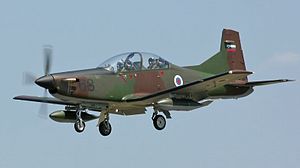
Back بيلاتوس بي سي-9 Arabic PC-9 Bulgarian Pilatus PC-9 BS Pilatus PC-9 Czech Pilatus PC-9 German Pilatus PC-9 Spanish پسسی-۹ Persian Pilatus PC-9 French Pilatus PC-9 Croatian PC–9 Hungarian
| PC-9 | |
|---|---|
 Pilatus PC-9M of the Slovenian Armed Forces | |
| General information | |
| Type | Basic/advanced trainer aircraft |
| National origin | Switzerland |
| Manufacturer | Pilatus Aircraft |
| Status | Active service |
| Primary users | Swiss Air Force |
| Number built | 265 |
| History | |
| Manufactured | 1984–present |
| First flight | 7 May 1984 |
| Developed from | Pilatus PC-7 |
| Developed into | T-6 Texan II |
The Pilatus PC-9 is a single-engine, low-wing tandem-seat turboprop training aircraft designed and manufactured by Pilatus Aircraft of Switzerland.
Developed as a more powerful evolution of the preceding Pilatus PC-7, the PC-9 features an enlarged cockpit and a ventral airbrake while possessing only a low level of structural commonality with its predecessor. During May 1985, the maiden flight of the prototype PC-9 was conducted; four months later, type certification was received and permitting deliveries to commence that same year. During the mid-1980s, Pilatus teamed up with British Aerospace to market the PC-9; the first production order for the type was placed by the Royal Saudi Air Force.
Production of the PC-9 has continued into the twenty-first century and in excess of 250 aircraft have been produced across five different variants. One of these variants, the Beechcraft T-6A Texan II, has been produced under licence by the American firm Beechcraft in the United States. The PC-9 has also been assembled by the Australian company Hawker de Havilland. The PC-9 has been employed by a number of military and civilian operators around the world, including the Swiss Air Force, Croatian Air Force, Royal Thai Air Force and the Irish Air Corps. It has been flown by aerobatics teams, such as the Royal Thai Air Force's Blue Phoenix and the Royal Australian Air Force's Roulettes. Furthermore, the type has occasionally been involved in combat operations.